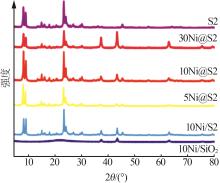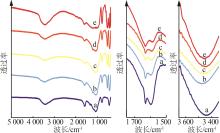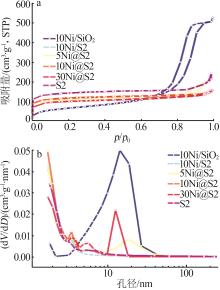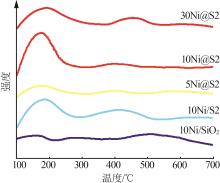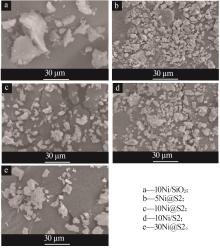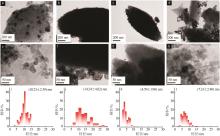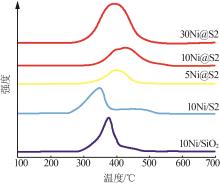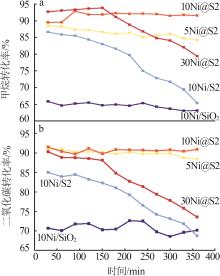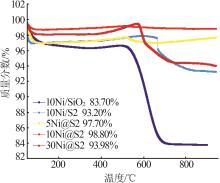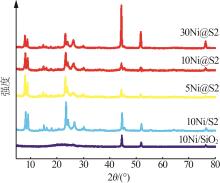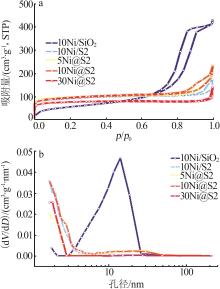Inorganic Chemicals Industry ›› 2025, Vol. 57 ›› Issue (2): 138-146.doi: 10.19964/j.issn.1006-4990.2024-0242
• Catalytic Materials • Previous Articles
Effect of confined catalyst Ni@S2 on performance of methane dry reforming reaction
ZHU Jicheng( ), YANG Qixin, LIANG Haoquan, WANG Zengkun, OUYANG Fugui, DI Jing, GAI Xikun(
), YANG Qixin, LIANG Haoquan, WANG Zengkun, OUYANG Fugui, DI Jing, GAI Xikun( )
)
- College of Biological and Chemical Engineering,Zhejiang University of Science and Technology,Hangzhou 310023,China
-
Received:2024-04-29Online:2025-02-10Published:2025-02-20 -
Contact:GAI Xikun E-mail:362549267@qq.com;gaixikun@163.com
CLC Number:
Cite this article
ZHU Jicheng, YANG Qixin, LIANG Haoquan, WANG Zengkun, OUYANG Fugui, DI Jing, GAI Xikun. Effect of confined catalyst Ni@S2 on performance of methane dry reforming reaction[J]. Inorganic Chemicals Industry, 2025, 57(2): 138-146.
share this article
Table 1
Pore structure analysis of different catalysts"
| 催化剂 | a表面积/ (m2·g-1) | b孔体积/ (cm3·g-1) | 孔径/ nm | c粒径/ nm | ||||
|---|---|---|---|---|---|---|---|---|
反应 前 | 反应 后 | 反应 前 | 反应 后 | 反应 前 | 反应 后 | 反应 前 | 反应后 | |
| S2 | 558.30 | 0.38 | 5.41 | |||||
| 10Ni/SiO2 | 230.27 | 203.48 | 0.77 | 0.63 | 14.20 | 14.26 | 9.58 | 21.3 |
| 10Ni/S2 | 432.34 | 349.87 | 0.21 | 0.13 | 5.23 | 2.34 | 11.32 | 24.9 |
| 5Ni@S2 | 411.49 | 405.32 | 0.13 | 0.14 | 3.07 | 3.07 | 5.66 | 5.64 |
| 10Ni@S2 | 397.93 | 393.63 | 0.11 | 0.12 | 3.49 | 3.22 | 4.63 | 4.72 |
| 30Ni@S2 | 369.44 | 287.43 | 0.10 | 0.11 | 4.36 | 1.97 | 9.34 | 26.2 |
| 1 | CHEN Siyuan, LIU Jiangfeng, ZHANG Qi,et al.A critical review on deployment planning and risk analysis of carbon capture,utilization,and storage(CCUS) toward carbon neutrality[J].Renewable and Sustainable Energy Reviews,2022,167:112537. |
| 2 | ABBASI K R, HUSSAIN K, RADULESCU M,et al.Does natural resources depletion and economic growth achieve the carbon neutrality target of the UK?A way forward towards sustainable development[J].Resources Policy,2021,74:102341. |
| 3 | YANG Songxi, YANG Jian, SHI Shuo,et al.The rising impact of urbanization-caused CO2 emissions on terrestrial vegetation[J].Ecological Indicators,2023,148:110079. |
| 4 | WANG Fang, HARINDINTWALI J D, YUAN Zhizhang,et al.Technologies and perspectives for achieving carbon neutrality[J].The Innovation,2021,2(4):100180. |
| 5 | SOVACOOL B K, BAZILIAN M D, KIM J,et al.Six bold steps towards net-zero industry[J].Energy Research & Social Science,2023,99:103067. |
| 6 | LA PAROLA V, LIOTTA L F, PANTALEO G,et al.CO2 reforming of CH4 over Ni supported on SiO2 modified by TiO2 and ZrO2:Effect of the support synthesis procedure[J].Applied Catalysis A:General,2022,642:118704. |
| 7 | GUHAROY U, REINA T R, LIU Jian,et al.A theoretical overview on the prevention of coking in dry reforming of methane using non-precious transition metal catalysts[J].Journal of CO2 Utilization,2021,53:101728. |
| 8 | GONZÁLEZ-CASTAÑO M, LE SACHÉ E, BERRY C,et al.Nickel phosphide catalysts as efficient systems for CO2 upgrading via dry reforming of methane[J].Catalysts,2021,11(4):446. |
| 9 | LI Jianwei, LI Jun, ZHU Qingshan.Carbon deposition and catalytic deactivation during CO2 reforming of CH4 over Co/MgO catalyst[J].Chinese Journal of Chemical Engineering,2018,26(11):2344-2350. |
| 10 | 胡明亮,周微,李滨,等.协同效应催化甲烷二氧化碳重整研究进展[J].无机盐工业,2024,56(1):23-32. |
| HU Mingliang, ZHOU Wei, LI Bin,et al.Research progress of synergistic effect catalytic reforming of methane and carbon dioxide[J].Inorganic Chemicals Industry,2024,56(1):23-32. | |
| 11 | ZHANG Qiulin, WANG Mingzhi, ZHANG Tengfei,et al.A stable Ni/SBA-15 catalyst prepared by the ammonia evaporation method for dry reforming of methane[J].RSC Advances,2015,5(114):94016-94024. |
| 12 | SETIABUDI H D, CHONG C C, ABED S M,et al.Comparative study of Ni-Ce loading method:Beneficial effect of ultrasonic-assisted impregnation method in CO2 reforming of CH4 over Ni-Ce/SBA-15[J].Journal of Environmental Chemical Engineering,2018,6(1):745-753. |
| 13 | WANG Luhui, LIU Hui, YE Han,et al.Vacuum thermal treated Ni-CeO₂/SBA-15 catalyst for CO₂ methanation[J].Nanomaterials,2018,8(10):759. |
| 14 | WANG Chengtao, ZHANG Jian, QIN Gangqiang,et al.Direct conversion of syngas to ethanol within zeolite crystals[J].Chem,2020,6(3):646-657. |
| 15 | WANG Chengtao, WANG Liang, ZHANG Jian,et al.Product selectivity controlled by zeolite crystals in biomass hydrogenation over a palladium catalyst[J].Journal of the American Chemical Society,2016,138(25):7880-7883. |
| 16 | 狄璐,王卫国,陈珏先,等.过渡金属负载Silicalite-1分子筛的制备及其催化糠醛加氢性能研究[J].无机盐工业,2024,56(4):125-132. |
| DI Lu, WANG Weiguo, CHEN Juexian,et al.Study on preparation of transition metal-supported Silicalite-1 zeolite catalyst and its catalytic performance for furfural hydrogenation[J].Inorganic Chemicals Industry,2024,56(4):125-132. | |
| 17 | DENG Min, MA Jun, LIU Yuantong,et al.Pd nanoparticles confined in pure Silicalite-2 zeolite with enhanced catalytic performance for the dehydrogenation of formic acid at room temperatu- re[J].Fuel,2023,333:126466. |
| 18 | WANG Jiyang, FU Yu, KONG Wenbo,et al.Design of a carbon-resistant Ni@S-2 reforming catalyst:Controllable Ni nanoparticles sandwiched in a peasecod-like structure[J].Applied Catalysis B:Environmental,2021,282:119546. |
| 19 | ZHANG Yidan, LI Shuqing, FU Yu,et al.Local coordination environment triggers key Ni-O-Si copolymerization on silicalite-2 for dry reforming of methane[J].Applied Catalysis B:Environment and Energy,2024,350:123903. |
| 20 | 盖希坤,杨丹,朱继成,等.嵌入型Ni@S1催化剂的制备及其CH4-CO2重整反应性能[J].洁净煤技术,2022,28(5):71-80. |
| GAI Xikun, YANG Dan, ZHU Jicheng,et al.Preparation and performance of embedded type Ni@S1 catalyst for CH4-CO2 reforming reaction[J].Clean Coal Technology,2022,28(5):71-80. | |
| 21 | WANG Yi, MI Jinxing, WU Zhongshuai.Recent status and challenging perspective of high entropy oxides for chemical cataly- sis[J].Chem Catalysis,2022,2(7):1624-1656. |
| 22 | TORREZ-HERRERA J J, KORILI S A, GIL A.Recent progress in the application of Ni-based catalysts for the dry reforming of methane[J].Catalysis Reviews,2023,65(4):1300-1357. |
| 23 | GAI Xikun, YANG Dan, TANG Ruiyuan,et al.Preparation of Ni-Co/SiO2 catalyst by ammonia reflux impregnation and its CH4-CO2 reforming reaction performance[J].Fuel,2022,316:123337. |
| 24 | LV Hongwei, GUO Wenxin, CHEN Min,et al.Rational construction of thermally stable single atom catalysts:From atomic structure to practical applications[J].Chinese Journal of Catalysis,2022,43(1):71-91. |
| 25 | 刘国东.ZnO改性纳米Silicalite-1沸石表面酸性及催化性能的研究[D].大连:大连理工大学,2019. |
| LIU Guodong.Study on surface acidity and catalytic performance of nano-Silicalite-1 zeolite modified by ZnO[D].Dalian:Dalian University of Technology,2019. | |
| 26 | ALHASSAN A M, HUSSAIN I, TAIALLA O A,et al.Advances in catalytic dry reforming of methane(DRM):Emerging trends,current challenges,and future perspectives[J].Journal of Cleaner Production,2023,423:138638. |
| 27 | MOVASATI A, ALAVI S M, MAZLOOM G.Dry reforming of methane over CeO2-ZnAl2O4 supported Ni and Ni-Co nano-catalysts[J].Fuel,2019,236:1254-1262. |
| 28 | LU Peng, RISWAN M, CHANG Xiaoning,et al.Hydrogenation of CO2 to light olefins on ZZ/MnSAPO-34@Si-2:Effect of silicalite-2 seeds on the acidity and catalytic activity[J].Fuel,2022,330:125470. |
| [1] | LIU Huangfei, ZHANG Li, LIU Tao. Research progress of fast synthesis technologies of zeolites [J]. Inorganic Chemicals Industry, 2025, 57(2): 36-43. |
| [2] | LUO Chengling, FAN Xiaofan. Research progress of microstructure-regulated catalysts for urea oxidation reactions [J]. Inorganic Chemicals Industry, 2025, 57(2): 26-35. |
| [3] | FAN Jingxin, LI Bin, HONG Luwei, HONG Meihua, GONG Xin. Research status and prospects of olefin removal catalyst from aromatic reforming oil [J]. Inorganic Chemicals Industry, 2025, 57(2): 14-25. |
| [4] | LIU Guangming. Study on photocatalytic and mechanical properties of C3N5/NH2-MIL-125(Ti) modified concrete mortar [J]. Inorganic Chemicals Industry, 2025, 57(1): 120-128. |
| [5] | SUN Qinghao, LI Keyan, GUO Xinwen. Study on photocatalytic benzyl alcohol oxidation coupled with hydrogen production over Pd/ZnIn2S4 nanosheets [J]. Inorganic Chemicals Industry, 2025, 57(1): 113-119. |
| [6] | WANG Yawen, WANG Fangfang, GENG Siyu, JU Jia, CHEN Lei, CHEN Changdong. Study on preparation and photocatalytic performance of SrTiO3-SrWO4 [J]. Inorganic Chemicals Industry, 2024, 56(7): 143-149. |
| [7] | LI Yongheng, MI Xiaotong, ZHANG Peipei. Synthesis of holycrystalline nano-ZSM-5 aggregate and its application in methylation of toluene [J]. Inorganic Chemicals Industry, 2024, 56(5): 135-140. |
| [8] | LI Jiangpeng, ZHANG Huibin. Synergistic degradation of methylene blue by photo-Fenton and photocatalytic with 3D porous LaFeO3/CeO2/SrTiO3 [J]. Inorganic Chemicals Industry, 2024, 56(5): 141-148. |
| [9] | WANG Chao, SONG Guoliang, XIAO Han. Industrial application of THFS-2 sulfurized reforming prehydrogenation catalysts [J]. Inorganic Chemicals Industry, 2024, 56(5): 94-100. |
| [10] | DI Lu, WANG Weiguo, CHEN Juexian, WU Chuanshu. Study on preparation of transition metal-supported Silicalite-1 zeolite catalyst and its catalytic performance for furfural hydrogenation [J]. Inorganic Chemicals Industry, 2024, 56(4): 125-132. |
| [11] | TANG Bei. Preparation of ZnO/g-C3N4 heterojunction photocatalytic material and its degradation of pyridine [J]. Inorganic Chemicals Industry, 2024, 56(4): 133-142. |
| [12] | ZHU Jinjian, YANG Xiaxia, MU Zhanpeng, SONG Guoliang, LI Zihan, LIU Wei, XU Yan, ZHANG Jingcheng. Effect of different additives on liquid phase selective hydrogenation performance of maleic anhydride over Ni/Al2O3 [J]. Inorganic Chemicals Industry, 2024, 56(4): 143-150. |
| [13] | ZHOU Xuan, LI Mengrui, CHEN Yichen, FAN Huiqiang, WANG Bin, YUAN Gang. Research progress of nickel-based phosphide composites in improving of catalytic water electrolysis for hydrogen evolution performance [J]. Inorganic Chemicals Industry, 2024, 56(4): 8-15. |
| [14] | HU Mingliang, ZHOU Wei, LI Bin, LAI Xiaoling. Research progress of synergistic effect catalytic reforming of methane and carbon dioxide [J]. Inorganic Chemicals Industry, 2024, 56(1): 23-32. |
| [15] | CHEN Xu, YANG Gang, LI Haitao. Study on preparation of multistage pore nano-SAPO-34 molecular sieves and its methanol to olefin performance [J]. Inorganic Chemicals Industry, 2024, 56(1): 134-140. |
| Viewed | ||||||
|
Full text |
|
|||||
|
Abstract |
|
|||||
|
||
